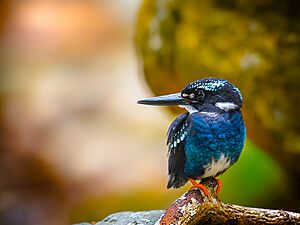Southern silvery kingfisher facts for kids
Quick facts for kids Southern silvery kingfisher |
|
|---|---|
 |
|
| Conservation status | |
| Scientific classification | |
| Genus: |
Ceyx
|
| Species: |
argentatus
|
| Synonyms | |
|
Alcedo argentata |
|
The southern silvery kingfisher (Ceyx argentatus) is a small, colorful bird. It lives only in the Philippines. You can find it on the islands of Mindanao and Basilan. This bird loves tropical forests, especially near streams and rivers. It's known for its bright colors and quick movements. Sadly, its home is shrinking, which means it needs our help to survive.
In the Philippines, people sometimes call this bird kasay-kasay. It even appears in an old story. This story is about how the Catholic image of Our Lady of Caysasay was found.
Contents
What Does It Look Like?
The southern silvery kingfisher is a very striking bird. It's quite small and moves very fast! Its body is mostly a dark blue color. It has a bright white throat and belly. You can also see a white patch behind its cheek. There is a small white spot near its nose.
A special feature is a pale, shiny blue stripe. This stripe goes down its back all the way to its tail. Its head and wings have small whitish spots. Its legs are a bright red color. These features make it easy to spot!
When it flies, it often makes a simple, high-pitched sound. It sounds like "tseep."
How Is It Different?
There is also a northern silvery kingfisher. It lives in a different part of the Philippines, in the Visayas. The southern kingfisher has a bluish-white throat, cheek, and belly. The northern one has cream-colored parts instead. This helps scientists tell them apart.
Where Does It Live?
This kingfisher lives in forests. It prefers streams and ponds in lowlands. You can find it up to 1,000 meters (about 3,300 feet) high. It can live in forests that have been partly cut down. It can even be found near coconut farms if they are close to a forest.
Why Is It Important to Protect It?
The southern silvery kingfisher is currently considered "near threatened." This means it could become endangered soon. Scientists believe there are about 1,500 to 7,000 adult birds left.
The biggest danger to this bird is habitat loss. This happens when its forest home is destroyed. People cut down trees for wood. They also clear land for farming or mining.
When forests are cut down, soil can wash into rivers. This makes the water muddy. Kingfishers need clear water to find food. Pollution in rivers can also harm them. Protecting these forests and rivers helps the kingfisher survive.


